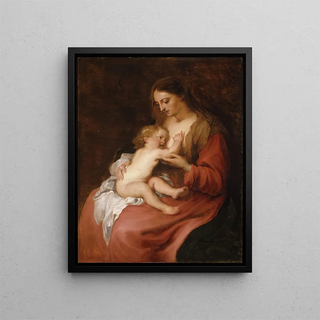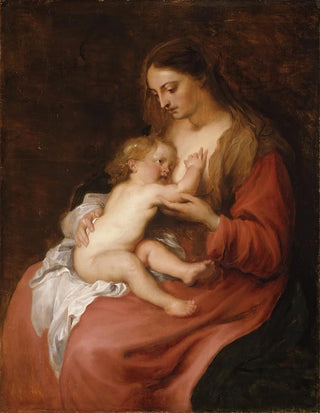Art print | Virgin and Child - Antoine van Dyck Source: Reproduction | Vierge à l'Enfant - Antoine van Dyck


View from behind

Frame (optional)
Reproduction Vierge à l'Enfant - Antoine van Dyck – Introduction captivante
The "Vierge à l'Enfant" by Antoine van Dyck is a work that transcends the simple framework of religious painting to become a true ode to motherhood and tenderness. Captured with extraordinary delicacy, this depiction of the Virgin Mary holding her child Jesus evokes an emotional depth that touches the viewer. The artist, known for his mastery of portraiture and his ability to bring out the personality of his subjects, manages here to infuse a palpable life into his sacred figures. Through this piece, van Dyck does not merely recount a biblical scene; he invites us to share a moment of sacred intimacy, where tenderness and protection blend in an act of devotion.
Style and uniqueness of the work
Van Dyck's style is distinguished by his masterful use of light and shadow, creating a contrast that brings the characters to life. In "Vierge à l'Enfant," the light gently caresses the faces, highlighting expressions of serenity and happiness. The sumptuous drapery of the Virgin's clothing, painted with meticulous attention, reveals an almost tangible texture, while warm, soft hues enhance the atmosphere of peace and protection. This work also stands out for its harmonious composition, where flowing lines guide the eye toward the center of the image, emphasizing the bond between mother and child. Every detail, from Marie's knowing gaze to the delicate posture of the child, demonstrates rare artistic sensitivity, making this painting a timeless masterpiece.
The artist and his influence
Antoine van Dyck, a pupil of Rubens, established himself as one of the masters of Flemish baroque. His journey, marked by stays in Italy, enriched his artistic approach, allowing him to incorporate classical influences into his flamboyant style. As a court portraitist in England, he captured the essence of his models with unmatched finesse, but it is in his religious works, such as the "Vierge à l'Enfant," that he reveals another facet of his talent.

Matte finish

View from behind

Frame (optional)
Reproduction Vierge à l'Enfant - Antoine van Dyck – Introduction captivante
The "Vierge à l'Enfant" by Antoine van Dyck is a work that transcends the simple framework of religious painting to become a true ode to motherhood and tenderness. Captured with extraordinary delicacy, this depiction of the Virgin Mary holding her child Jesus evokes an emotional depth that touches the viewer. The artist, known for his mastery of portraiture and his ability to bring out the personality of his subjects, manages here to infuse a palpable life into his sacred figures. Through this piece, van Dyck does not merely recount a biblical scene; he invites us to share a moment of sacred intimacy, where tenderness and protection blend in an act of devotion.
Style and uniqueness of the work
Van Dyck's style is distinguished by his masterful use of light and shadow, creating a contrast that brings the characters to life. In "Vierge à l'Enfant," the light gently caresses the faces, highlighting expressions of serenity and happiness. The sumptuous drapery of the Virgin's clothing, painted with meticulous attention, reveals an almost tangible texture, while warm, soft hues enhance the atmosphere of peace and protection. This work also stands out for its harmonious composition, where flowing lines guide the eye toward the center of the image, emphasizing the bond between mother and child. Every detail, from Marie's knowing gaze to the delicate posture of the child, demonstrates rare artistic sensitivity, making this painting a timeless masterpiece.
The artist and his influence
Antoine van Dyck, a pupil of Rubens, established himself as one of the masters of Flemish baroque. His journey, marked by stays in Italy, enriched his artistic approach, allowing him to incorporate classical influences into his flamboyant style. As a court portraitist in England, he captured the essence of his models with unmatched finesse, but it is in his religious works, such as the "Vierge à l'Enfant," that he reveals another facet of his talent.






